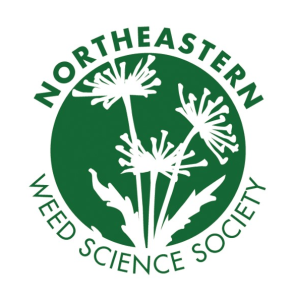Stewardship
NEWSS Supports Herbicide Resistance Stewardship
Weeds reduce yield, quality, and profitability of agricultural production systems. Herbicides are the predominant form of weed control implemented by farmers and land managers because they are highly effective, economical, and have many benefits to crop production systems. Agriculture in the northeastern region of the United States would be severely limited if cost-effective weed control strategies were not available.
The loss of herbicide effectiveness due to selection of herbicide-resistant weed populations has a negative impact on farmers. Herbicide resistance is the inability of a herbicide to effectively control a weed species that was previously controlled by the same herbicide. Herbicide resistance is detected when a biotype within a weed species possessing a resistant trait increases in abundance while susceptible biotypes are controlled by use of the herbicide. The resistant trait is inheritable and therefore is passed from one generation to the next. Once a herbicide-resistant population has been selected for, the likelihood of the weed population reverting back to a population dominated by the susceptible biotype is low.
Herbicides with new modes of action are not being developed and brought to the marketplace as frequently as they had been in the past. As a result, herbicides with a new mode of action will not likely serve as a solution for herbicide-resistant weed populations. Therefore, it is increasingly important that the herbicide options presently available be maintained through sound product stewardship. Stewardship implies that whoever produces, sells, or uses a herbicide exercises all precautions for minimizing any undesirable effects of the herbicide, including selection of resistant biotypes.
Crop rotation alone does not ensure that different herbicide modes of action are being used from year-to-year since herbicides with certain modes of action can be used in a wide variety of crops. It is important for users to know what herbicides have been used in the past to avoid heavy (exclusive) use of the same mode of action on the treated crop land. The Northeastern Weed Science Society recognizes the US Environmental Protection Agency’s (EPA) voluntary program providing information to users of a pesticide’s mode of action. (The document Pesticide Registration Notice 2001-5notes “This document provides acceptable schemes of classification of pesticides according to their mode/target site of action, a standard format for showing group identification symbols on the end-use product labels, and examples of resistance management labeling in the use directions”)
Product stewardship is critically important with herbicide-resistant crops. Herbicide-resistant crops allow for the use of herbicide(s) that previously would have severely injured or killed the crop without the herbicide-resistant trait. In some situations, this allows a herbicide or herbicides with the same mode of action to be used multiple times during a cropping season or on multiple crops in a rotation, putting high selection pressure on weed populations. This increases the importance of herbicide stewardship for these cropping practices and the importance of non-chemical weed control, crop and herbicide rotation, and use of herbicide combinations or sequential herbicides with different modes of action. The use of herbicide-resistant crops does not increase the risk of herbicide-resistant weeds; it is the repeated use of the same mode of action herbicide(s) without inclusion of other weed control tools that select for resistant weed populations.
Many factors need to be considered when developing herbicide-resistance management strategies. More detailed information can be obtained from your land grant university and its Cooperative Extension specialists. An additional source of information is the Herbicide Resistance Action Committee. The Herbicide Resistance Action Committee (HRAC) is an industry initiative to facilitate the effective management of herbicide resistance.
Herbicide stewardship and herbicide resistance management are critical in minimizing the risk of selecting herbicide-resistant weed biotypes with their increased management and/or production costs. The Northeastern Weed Science Society supports efforts to increase implementation of herbicide resistance stewardship.
Prepared by the NEWSS Herbicide Resistance Plant Committee. This document is not an endorsement by the NEWSS of additional government regulations.
